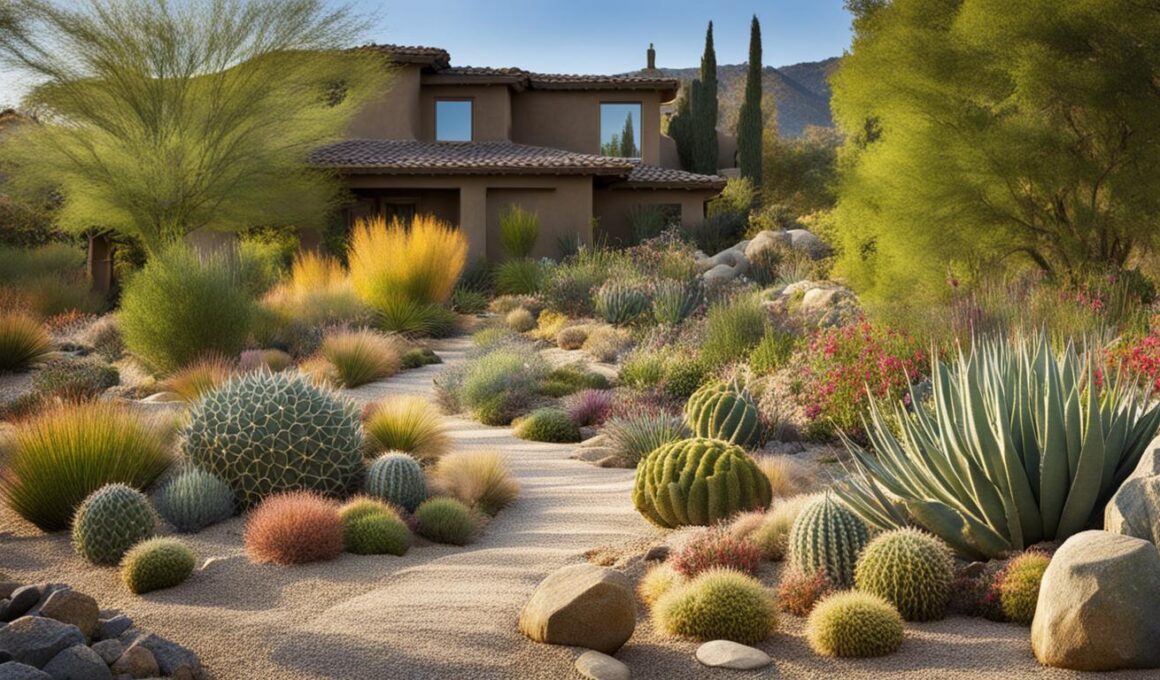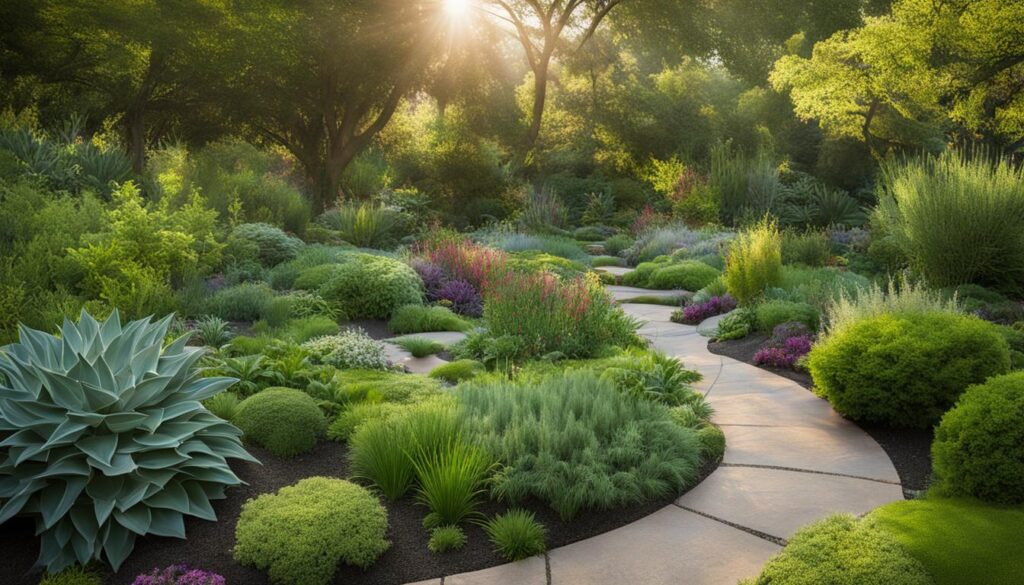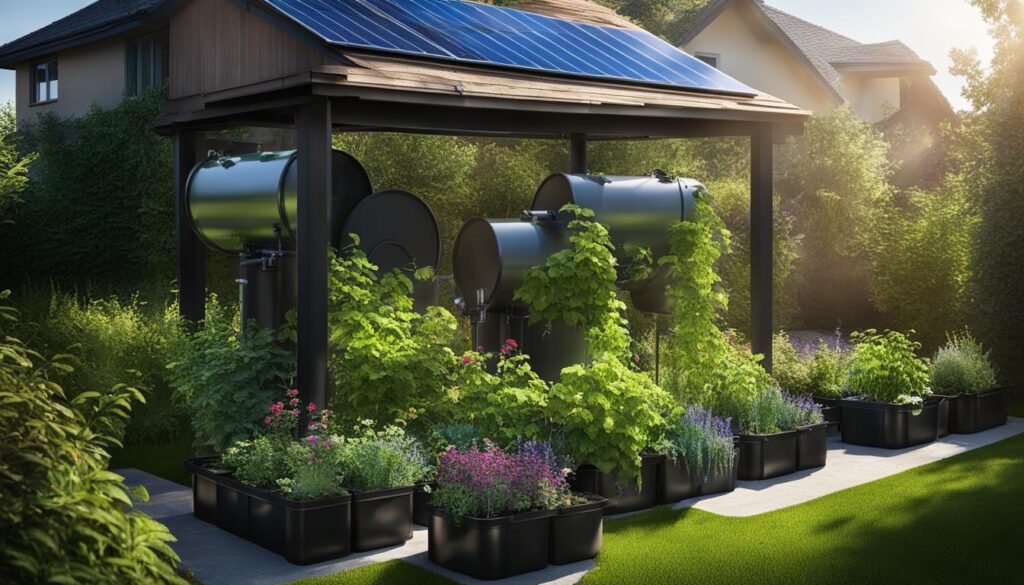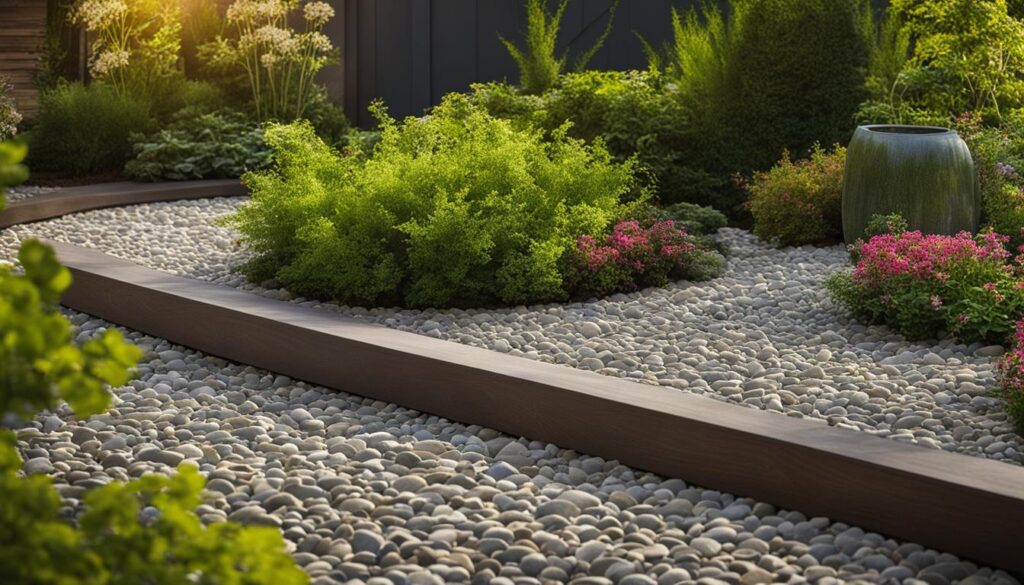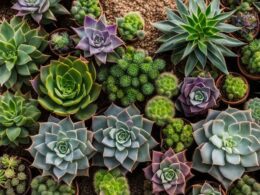Are you looking for ways to create a beautiful outdoor space that is both environmentally-friendly and energy-efficient? Look no further than xeriscaping. This innovative landscaping technique focuses on reducing water usage and increasing energy efficiency, making it the perfect choice for eco-conscious homeowners.
Xeriscaping incorporates native plants, optimizes irrigation, and harnesses rainwater to create a sustainable and visually appealing landscape. By embracing xeriscaping principles, not only can you lower your water bills, but you can also contribute to water conservation, improve air quality, enhance biodiversity, and reduce stormwater runoff.
Key Takeaways
- Xeriscaping is an environmentally-friendly landscaping technique that focuses on reducing water usage and increasing energy efficiency.
- By incorporating native plants, optimizing irrigation, and harnessing rainwater, xeriscaping can create a sustainable and beautiful outdoor space.
- Xeriscaping offers numerous benefits, including water conservation, reduced energy consumption, improved air quality, enhanced biodiversity, and reduced stormwater runoff.
- Using native plants in your landscape design is crucial for energy efficiency, as they require less water, fertilizers, and pesticides.
- Optimizing irrigation through regular inspections, drip irrigation, and smart irrigation controllers can help conserve water and prevent over-watering.
The Benefits of Xeriscaping for Energy Efficiency
When it comes to creating an energy-efficient landscape, xeriscaping offers a multitude of benefits. By implementing this sustainable landscaping technique, you can not only reduce water consumption but also minimize energy usage, improve air quality, enhance biodiversity, and mitigate stormwater runoff.
“Xeriscaping promotes water conservation by using drought-tolerant plants and minimizing the need for irrigation,” explains landscape architect Jane Williams. This approach involves selecting native plants that are well-adapted to the local climate, resulting in lower water requirements and less reliance on irrigation systems. By reducing the amount of water needed for landscaping, xeriscaping helps conserve this precious resource and supports sustainable water management practices.
In addition to water conservation, xeriscaping has a positive impact on energy consumption. Strategic placement of trees for shade can provide natural cooling, reducing the need for air conditioning during hot summer months. By creating windbreaks with evergreen trees and shrubs, xeriscaping helps block cold winds in winter, minimizing heating costs. These natural cooling and heating techniques contribute to energy efficiency and lower utility bills.
Furthermore, xeriscaping plays a crucial role in improving air quality and enhancing biodiversity. Native plants attract pollinators such as bees and butterflies, promoting a healthier ecosystem. The presence of diverse plant life also contributes to cleaner air by absorbing carbon dioxide and releasing oxygen. By creating a habitat for wildlife, xeriscaping supports local ecosystems and fosters a balanced and sustainable environment.
“An energy-efficient landscape not only benefits the environment but also provides a beautiful and tranquil outdoor space for you to enjoy,” says Jane Williams. By implementing xeriscaping techniques, you can create a sustainable oasis that reduces water consumption, saves energy, improves air quality, supports biodiversity, and minimizes stormwater runoff. Start transforming your landscape today and reap the many rewards of xeriscaping.
Key Benefits of Xeriscaping for Energy Efficiency:
- Water conservation through the use of drought-tolerant plants
- Reduced energy consumption by strategically planting trees for shade
- Improved air quality through the promotion of biodiversity
- Enhanced biodiversity by attracting local wildlife
- Minimized stormwater runoff, contributing to sustainable water management
Designing an Energy-Efficient Landscape with Native Plants
When it comes to creating an energy-efficient landscape, incorporating native plants is a must. Native plants are perfectly adapted to the local climate, making them more resilient and requiring less maintenance. By choosing drought-tolerant species, you can conserve water and reduce the need for excessive irrigation, contributing to overall water conservation efforts.
Not only do native plants help save water, but they also support local ecosystems. These plants provide habitats and food sources for native wildlife, promoting biodiversity in your landscape. By fostering a healthy ecosystem, you are contributing to the preservation of your local environment.
Benefits of Native Plants in Energy-Efficient Landscaping:
- Drought-tolerant: Native plants are naturally adapted to local climate conditions, reducing the need for excessive watering.
- Water conservation: By selecting native plants, you can conserve water and contribute to overall water conservation efforts.
- Eco-friendly landscaping: Native plants support local ecosystems by providing habitat and food sources for native wildlife.
“Incorporating native plants into your landscape not only helps conserve water but also creates a harmonious relationship with the surrounding environment.” – Landscaping Expert
When designing your energy-efficient landscape, consider the various native plants that thrive in your region. Research the optimal conditions for each species and choose plants that require minimal watering and maintenance. By carefully selecting and placing native plants, you can create a beautiful and sustainable outdoor space that benefits both you and the environment.
Optimizing Irrigation for Energy Efficiency
Efficient irrigation plays a crucial role in creating an energy-efficient landscape. By implementing smart strategies and technologies, you can minimize water waste and reduce your overall energy consumption. Here are some key tips to optimize irrigation and promote sustainable water conservation:
1. Embrace Drip Irrigation
Consider utilizing drip irrigation systems instead of traditional sprinklers. Drip irrigation delivers water directly to the roots of plants, reducing evaporation and ensuring efficient water usage. This targeted approach not only conserves water but also helps prevent weed growth and keeps foliage dry, minimizing the risk of diseases.
2. Invest in a Smart Irrigation Controller
A smart irrigation controller is a valuable investment for optimizing your watering schedules. These controllers use weather data, soil moisture sensors, and plant water needs to automatically adjust watering times and frequencies. By syncing your irrigation system with real-time conditions, you can prevent over-watering, reduce water waste, and promote a healthier, more sustainable landscape.
3. Group Plants with Similar Water Needs
When planning your landscape design, group plants with similar water requirements together. This allows you to target your irrigation and avoid over- or under-watering certain areas. By tailoring your watering approach to the specific needs of different plant zones, you can maximize water conservation and minimize unnecessary energy usage.
4. Regularly Inspect and Maintain Your Irrigation System
Leaky pipes, clogged sprinkler heads, and malfunctioning valves can significantly impact the efficiency of your irrigation system. Regularly inspecting and maintaining your system helps identify and fix any issues promptly. By keeping your irrigation system in optimal condition, you can ensure proper water distribution, minimize waste, and reduce the energy required to pump water through the system.
By implementing these irrigation optimization strategies, you can create an energy-efficient landscape that conserves water, minimizes energy consumption, and promotes sustainability.
Harnessing Rainwater for Energy-Efficient Landscaping
When it comes to creating an energy-efficient landscape, one key strategy is harnessing rainwater. By collecting and utilizing rainwater, you can reduce your reliance on freshwater sources and conserve water, while also promoting sustainable irrigation practices.
Investing in rain barrels or cisterns is a practical and eco-friendly way to capture rainwater from your roof. These containers can be strategically placed to collect and store rainwater, which can then be used for irrigation purposes. By incorporating a filtering system, you can ensure the water is clean and free from debris, maximizing the efficiency of rainwater collection.
In addition to reducing water usage, utilizing rainwater for irrigation offers other benefits as well. Since rainwater is naturally free of chemicals, it provides a healthier and more natural alternative to tap water for your plants. Furthermore, by reducing the demand for freshwater, rainwater harvesting helps to alleviate pressure on local water supplies and supports overall water conservation efforts.
Key Benefits of Rainwater Collection:
- Conserves water by reducing reliance on freshwater sources
- Provides a natural and chemical-free alternative for irrigation
- Supports water conservation efforts and reduces strain on local water supplies
- Maximizes the efficiency of rainwater collection through filtering systems
“Harnessing rainwater is a sustainable way to reduce water usage in your landscape.”
By incorporating rainwater harvesting into your energy-efficient landscape design, you can make a significant positive impact on the environment while enjoying the benefits of sustainable irrigation practices. Start collecting and utilizing rainwater today to create a greener and more efficient outdoor space.
Creating Shade and Windbreaks for Energy Efficiency
Strategic placement of shade trees and windbreaks can significantly enhance the energy efficiency of your outdoor space. By incorporating these natural elements, you can create a cooler and more comfortable environment while reducing your energy consumption. Shade trees, with their dense foliage and wide canopies, provide natural shade that helps to reduce the need for air conditioning. Not only does this lower your energy bills, but it also minimizes your carbon footprint.
Benefits of Shade Trees:
- Reduce the ambient temperature by several degrees
- Block sunlight from entering your home through windows and roofs
- Protect outdoor living areas from direct sunlight
- Enhance the aesthetic appeal of your landscape
Windbreaks, such as evergreen trees and shrubs, play a crucial role in energy efficiency during colder months. They act as natural barriers, blocking the wind and reducing heat loss from your home. By strategically planting windbreaks on the windward side of your property, you can create a shield that redirects the airflow, preventing it from reaching your home and reducing the need for heating.
Integrating shade trees and windbreaks into your landscape design is a cost-effective and sustainable way to improve energy efficiency. By harnessing nature’s power, you can create a more comfortable outdoor space while reducing your environmental impact.
Additionally, consider installing shade structures and using climbing vines to enhance shade in specific areas of your outdoor space. Pergolas, awnings, or even strategically placed umbrellas can provide extra shade and protection from the sun’s rays. Climbing vines on trellises or walls not only provide shade but also add beauty and texture to your landscape. These elements, combined with shade trees and windbreaks, can create a harmonious and energy-efficient outdoor oasis.
Can Xeriscaping be Implemented in Residential Landscaping for Energy Efficiency?
Xeriscaping can certainly be implemented in residential landscaping for energy efficiency. By incorporating innovative xeriscaping ideas, public parks have already shown how to conserve water while maintaining a beautiful landscape. Homeowners can follow suit by using native plants, efficient irrigation systems, and natural mulch to create a low-maintenance, sustainable garden.
Permeable Surfaces and Smart Technology for Energy Efficiency
One of the key elements in creating an energy-efficient landscape is the use of permeable surfaces. By incorporating materials such as gravel or permeable pavers, you can effectively manage stormwater runoff and reduce strain on existing stormwater systems. These surfaces allow water to infiltrate the ground, replenishing groundwater supplies and preventing erosion. Additionally, permeable surfaces help to filter pollutants and prevent them from entering water bodies, thus improving overall water quality.
To further enhance energy efficiency in your landscape, consider integrating smart technology. Utilizing weather-based irrigation controllers can optimize watering schedules based on real-time weather data, ensuring that your plants receive the precise amount of water they need without wasting excess. By automating your irrigation system, you can conserve water and reduce the risk of overwatering. Smart technology can also extend to lighting systems, allowing for energy-saving LED lights that consume less electricity compared to traditional lighting options.
Implementing permeable surfaces and smart technology in your landscape not only reduces your environmental impact but also offers practical benefits. By promoting efficient irrigation practices and utilizing energy-saving lighting, you can significantly lower your water and energy bills while maintaining a beautiful and sustainable outdoor space.
Key points:
- Permeable surfaces such as gravel or permeable pavers manage stormwater runoff and improve water quality.
- Smart technology, such as weather-based irrigation controllers, optimizes watering schedules based on real-time weather data.
- Energy-saving LED lighting reduces electricity consumption and lowers energy bills.
Conclusion
Xeriscaping is the key to creating an energy-efficient landscape that not only benefits the environment but also saves you money. By embracing xeriscaping techniques, you can transform your outdoor space into a sustainable oasis.
By incorporating native plants, you can ensure that your landscape thrives while reducing the need for excessive watering. The use of drought-tolerant species helps conserve water and supports local ecosystems, making your outdoor space more eco-friendly.
Optimizing irrigation is crucial for energy efficiency. Regularly inspecting your system for leaks and using targeted watering methods like drip irrigation can significantly reduce water consumption. Installing a smart irrigation controller based on weather data will also prevent over-watering and further maximize efficiency.
Lastly, harnessing rainwater through rain barrels or cisterns can be a game-changer in conserving water and reducing freshwater usage. By strategically placing rain barrels and using filtering systems, you can make the most of this sustainable irrigation solution.
Implementing xeriscaping techniques in your outdoor space not only creates an energy-efficient landscape but also promotes water conservation, improves air quality, enhances biodiversity, and reduces stormwater runoff. Start incorporating these practices today to create a beautiful and sustainable outdoor space that benefits both you and the environment.





